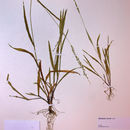Description
provided by eFloras
Perennials. Culms tufted, slender, straggling, 30–100 cm tall. Leaf sheaths glabrous or shortly hairy; leaf blades flat, rather thin, 6–16 × 0.2–1 cm, margins scabrous-pubescent, apex acute; ligule 3.8–5 mm. Panicle narrow, 5–20 cm; branches ascending or suberect. Spikelets oblong, 3–7 mm, pale green; glumes unequal, 5-veined, subacute; lower glume ovate, shorterthan upper; upper glume ovate-oblong, about 1/2 spikelet length; lemmas papery, 7-veined, subacute, awnless; sterile lemmas narrowly elliptic-oblong, finely pubescent to almost glabrous; lower sterile lemma smooth or rarely transversely wrinkled near apex; upper sterile lemma transversely wrinkled, 2 frill-like appendages on basal hook, sometimes bearded at base; fertile lemma ovate, smooth, glabrous, obtuse; palea 2-veined. Stamens 6, anthers 0.7–1.2 mm.
- license
- cc-by-nc-sa-3.0
- copyright
- Missouri Botanical Garden, 4344 Shaw Boulevard, St. Louis, MO, 63110 USA
Derivation of specific name
provided by Flora of Zimbabwe
erecta: erect
- license
- cc-by-nc
- copyright
- Mark Hyde, Bart Wursten and Petra Ballings
- bibliographic citation
- Hyde, M.A., Wursten, B.T. and Ballings, P. (2002-2014). Ehrharta erecta Lam. Flora of Zimbabwe website. Accessed 28 August 2014 at http://www.zimbabweflora.co.zw/speciesdata/species.php?species_id=103500
- author
- Mark Hyde
- author
- Bart Wursten
- author
- Petra Ballings
Description
provided by Flora of Zimbabwe
A variable, sparsely tufted grass. Despite the name it is often semi-erect, rooting at the lower nodes. The inflorescence branches are often deflexed (image 2).
- license
- cc-by-nc
- copyright
- Mark Hyde, Bart Wursten and Petra Ballings
- bibliographic citation
- Hyde, M.A., Wursten, B.T. and Ballings, P. (2002-2014). Ehrharta erecta Lam. Flora of Zimbabwe website. Accessed 28 August 2014 at http://www.zimbabweflora.co.zw/speciesdata/species.php?species_id=103500
- author
- Mark Hyde
- author
- Bart Wursten
- author
- Petra Ballings
Frequency
provided by Flora of Zimbabwe
Locally common in division E
- license
- cc-by-nc
- copyright
- Mark Hyde, Bart Wursten and Petra Ballings
- bibliographic citation
- Hyde, M.A., Wursten, B.T. and Ballings, P. (2002-2014). Ehrharta erecta Lam. Flora of Zimbabwe website. Accessed 28 August 2014 at http://www.zimbabweflora.co.zw/speciesdata/species.php?species_id=103500
- author
- Mark Hyde
- author
- Bart Wursten
- author
- Petra Ballings
Insects whose larvae eat this plant species
provided by Flora of Zimbabwe
Bicyclus safitza safitza (Common bush brown) Metisella metis paris (Gold-spotted sylph or -skipper) Bicyclus safitza safitza f. evenus (Common bush brown (dry season form)) Borbo borbonica borbonica (Olive-haired swift)
- license
- cc-by-nc
- copyright
- Mark Hyde, Bart Wursten and Petra Ballings
- bibliographic citation
- Hyde, M.A., Wursten, B.T. and Ballings, P. (2002-2014). Ehrharta erecta Lam. Flora of Zimbabwe website. Accessed 28 August 2014 at http://www.zimbabweflora.co.zw/speciesdata/species.php?species_id=103500
- author
- Mark Hyde
- author
- Bart Wursten
- author
- Petra Ballings
Physical Description
provided by USDA PLANTS text
Perennials, Terrestrial, not aquatic, Stems nodes swollen or brittle, Stems geniculate, decumbent, or lax, sometimes rooting at nodes, Stems caespitose, tufted, or clustered, Stems terete, round in cross section, or polygonal, Stem internodes hollow, Stems with inflorescence less than 1 m tall, Stems, culms, or scapes exceeding basal leaves, Leaves mostly cauline, Leaves conspicuously 2-ranked, distichous, Leaves sheathing at base, Leaf sheath mostly open, or loose, Leaf sheath smooth, glabrous, Leaf sheath hairy, hispid or prickly, Leaf sheath and blade differentiated, Leaf blades linear, Leaf blade auriculate, Leaf auricules setose or ciliate, Leaf blades 2-10 mm wide, Leaf blades mostly flat, Leaf blade margins folded, involute, or conduplicate, Leaf blades mostly glabrous, Leaf blades scabrous, roughened, or wrinkled, Ligule present, Ligule an unfringed eciliate membrane, Inflorescence terminal, Inflorescence an open panicle, openly paniculate, branches spreading, Inflorescence a contracted panicle, narrowly paniculate, branches appressed or ascending, Inflorescence solitary, with 1 spike, fascicle, glomerule, head, or cluster per stem or culm, Inflorescence lax, widely spreading, branches drooping, pendulous, Inflorescence a panicle with narrowly racemose or spicat e branches, Inflorescence branches more than 10 to numerous, Flowers bisexual, Spikelets pedicellate, Spikelets sessile or subsessile, Spikelets laterally compressed, Spikelet less than 3 mm wide, Spikelets with 1 fertile floret, Spikelets with 3-7 florets, Spikelet with 1 fertile floret and 1-2 sterile florets, Spikelets solitary at rachis nodes, Spikelets with 1 terminal fertile floret and 2 lateral staminate or sterile florets, Spikelets bisexual, Spikelets disarticulating above the glumes, glumes persistent, Spikelets disarticulating beneath or between the florets, Rachilla or pedicel glabrous, Glumes present, empty bracts, Glumes 2 clearly present, Glumes equal to or longer than adjacent lemma, Glumes keeled or winged, Glumes 3 nerved, Glumes 4-7 nerved, Lemma coriaceous, firmer or thicker in texture than the glumes, Lemma 5-7 nerved, Lemma rugose, with cross wrinkles, or roughened, Lemma apex truncate, rounded, or obtuse, Lemma awnless, Lemma margins thin, lying flat, Lemma straight, Palea present, well developed, Palea membranous, hyaline, Palea shorter than lemma, Stamens 6, Styles 2-fid, deeply 2-branched, Stigmas 2, Fruit - caryopsis, Caryopsis ellipsoid, longitudinally grooved, hilum long-linear.
Ehrharta erecta: Brief Summary
provided by wikipedia EN
Ehrharta erecta is a species of grass commonly known as panic veldtgrass. The species is native to Southern Africa and Yemen. It is a documented invasive species in the United States, New Zealand, Australia, southern Europe, and China.
The species is perennial, and normally grows to about 30 to 50 centimeters, although it may reach two meters in height. It will grow in a wide variety of habitats, even in shade.
The species has been used for birdseed, and in ecological restoration such as dune stabilization. However, it has become an invasive weed in many parts of the world. Flowering and seeding throughout the year, its seeds germinate rapidly, forming new plants in only a few weeks.
- license
- cc-by-sa-3.0
- copyright
- Wikipedia authors and editors

